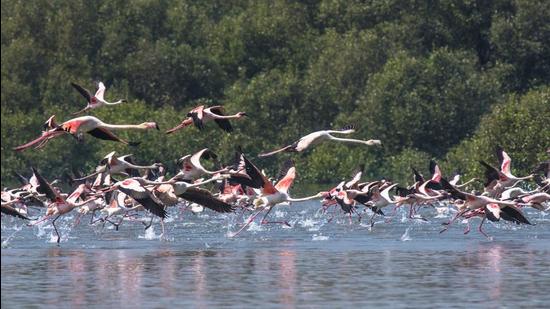‘70 species of waterfowl found at 99 sites along Maharashtra coast’
A two-year study by researchers at the Bombay Natural History Society (BNHS) wit the state angrove cell has recorded a total 70 species of waterfowl, including nine threatened species, at 99 monitoring sites, spread over Maharashtra’s 702-kilometre coastline.
A two-year study by researchers at the Bombay Natural History Society (BNHS) has recorded a total 70 species of waterfowl, including nine threatened species, at 99 monitoring sites, spread over Maharashtra’s 702-kilometre coastline.

Between 2017 and 2019, BNHS conducted a study with the state forest department’s mangrove cell to assess the migratory routes and habitat preferences of water birds wintering along the Maharashtra coast. The study also categorised Maharashtra’s coastal wetlands, which make up 10% of the state’s total wetland area, based on the number of birds observed during the study period. “Of the 99 sites monitored, seven supported over 1,000 water birds, six supported 500 to 1,000 water birds and six others supported 300 to 500 water birds during one or more survey periods,” says the report, a copy of which is with HT.
The list of recorded species includes nine from the International Union for Conservation of Nature’s (IUCN) red list of threatened species. These are the Great Knot (which is the only endangered species in the survey); the Asian Woollyneck and Indian Skimmer (categorised as vulnerable); the Black-tailed Godwit , Curlew Sandpiper, Black-headed Ibis, Eurasian Curlew, Eurasian Oystercatcher and Lesser Flamingo (categorised as near-threatened). The study recommends continuous monitoring of all sites “in order to understand the seasonality of use of these sites”.
Virender Tiwari, additional principal chief conservator of forests (mangrove cell), described BNHS’s findings as “pertinent” and said, “The wildlife department has tabled a proposal with the state to monitor not just coastal wetlands, but all wetlands in the state. The budget for this second study is ₹2.77 crore. We are awaiting in-principle approval.”
Of the sites, Akshi beach in Raigad is described as “very important” for “staging and wintering migratory shorebirds” since over 5,000 shorebirds have been counted here. The Great Knot was sighted at Akshi. All monitoring sites outside of the Mumbai bay area recorded consistent numbers during the study period.
At monitoring sites located within the Mumbai bay area, researchers recorded substantially larger flocks of water birds, but their counts varied drastically over the course of the study period. For example, Panje wetlands recorded about 2,500 water birds in December 2017, but no birds were recorded in October 2018 “due to high water level and disturbance”. Then, in December 2018, the count rose to over 12,000 water birds. Researchers have attributed these fluctuations to causes originating in human activity, like fishing or land reclamation. At Sewri jetty, for example, the number of visiting birds was impacted by the construction of the trans harbour link, which began during the study period.
Coastal wetlands in Maharashtra are important habitats for water-birds migrating along the Central Asian Flyway, an umbrella term that comprises multiple migratory routes spanning 30 countries between Siberia (in the north), west and south Asia, and the British Indian Ocean Territory.
“Inland and coastal wetlands of Maharashtra act as refuelling stations for birds that migrate further south and also during their return migration to the breeding sites... As they are the critical bottleneck sites for migratory birds, protecting such sites is of immense importance,” the report states.
Researchers at BNHS who worked on this study were not reachable for comment.



